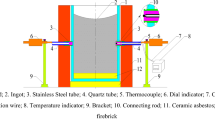Abstract
It is known from experimental data that for pure aluminum castings manufactured via the gravity die casting process, the interfacial heat-transfer coefficient can vary in the range 500 to 16,000 W/m2 K. These coefficients are of significant importance for the numerical simulation of the solidification process. The experimentally determined variation of interfacial heat-transfer coefficients with respect to time has been recalculated to highlight the variation with respect to casting temperature at the interface. This variation was observed to be of an exponential nature. Also, the pattern of variation was found to be similar in all the experimental results. It has been found that all these patterns of interfacial heat-transfer coefficient variation can be matched by a unique equation that has been proposed as a correlation to model the metal-mold interfacial heat transfer. The benefit of this correlation is in its ability to approximate the combined effects of geometry variation, insulation, chills, die coatings, air gap formation, etc. during the numerical simulation and its use in the optimal design of heat transfer at the metal-mold interface.
Similar content being viewed by others
Abbreviations
- ρ :
-
density (kg/m3)
- c :
-
specific heat (J/kg °C)
- k :
-
conductivity of the metal (W/m °C)
- H :
-
enthalpy (J/kg °C)
- t :
-
time (s)
- t f :
-
freezing time (s)
- T :
-
temperature (°C)
- Ω:
-
domain
- Γ:
-
domain boundary
- Γ q :
-
flux boundary
- Γ h :
-
convection boundary
- Γ t :
-
fixed temperature boundary
- q :
-
prescribed flux at the boundary Γ q
- h c :
-
convection heat-transfer coefficient (W/m2 °C)
- h :
-
metal-mold interfacial heat-transfer coefficient (W/m2 °C)
- C :
-
heat capacity matrix
- K :
-
conductivity matrix
- F :
-
load vector
- N :
-
standard finite element shape function
- l :
-
length of interface element
- k a :
-
conductivity of air
- δ ag :
-
macroscopic air gap
- r :
-
vector from casting’s geometric center to casting-mold interface
- n :
-
vector of interface normal
- α :
-
linear thermal expansion coefficient
- u s and T sol :
-
solidus temperature (°C)
- u :
-
average temperature over solidified metal
- T L :
-
liquidus temperature (°C)
- T int :
-
casting temperature at the interface (°C)
- x :
-
intermediate variable
- a 1, a 2, a 3 :
-
coefficients or constants in the correlation
- n :
-
number of user-defined feed metal flow paths
- s n :
-
number of points in the nth user-defined feed metal flow path
- p :
-
penalty term
References
R.W. Lewis, K. Morgan, H.R. Thomas, and K.N. Seetharamu: The Finite Element Method in Heat Transfer Analysis, John Wiley & Sons, New York, NY, 1996.
K. Ho and R.D. Pehlke: AFS Trans, 1984, vol. 92, pp. 587–98.
P. Schmidt and I.L. Svensson: TRITA-MAC-0541, The Royal Institute of Technology, Stockholm 1994.
M.R. Tadayon and R.W. Lewis: Cast Met., 1988, vol. 1, pp. 24–28.
D.M. Stefanescu, G. Upadhya, and D. Bandyopadhyay: Metall. Trans. A, 1990, vol. 21A, pp. 997–1005.
P. Chow, C. Bailey, M. Cross, and K. Pericleous: in Modeling of Casting, Welding and Advanced Solidification Process VII, M. Cross and J. Campbell, eds., London, TMS, Warrendale, PA, 1995, pp. 213–21.
H. Huang, V.K. Suri, J.L. Hill, and J.T. Berry: Trans. ASME—J. Eng. Mater. Technol., 1993, vol. 15, pp. 2–7.
P.R. Sahm and P.N. Hansen: Numerical Simulation and Modelling of Casting and Solidification Processes for Foundry and Cast House, International Committee of Foundry Technical Associations, Zurich, 1984.
T.E. Morthland, P.E. Byrne, D.A. Tortorelli, and J.A. Dantzig: Metall. Mater. Trans. B, 1995, vol. 26B, pp. 871–86.
D.A. Tortorelli, J.A. Tomasko, T.E. Morthland, and J.A. Dantzig: Comput. Meth. Appl. Mech. Eng., 1994, vol. 113, pp. 157–72.
Y. Nishida, W. Droste, and S. Engler: Metall. Trans. B, 1986, vol. 17B pp. 833–44.
N.A. Mahallawy and A.M. Assar: J. Mater. Sci. Lett., 1988, vol. 7, pp. 205–08.
N.A. Mahallaway and A.M. Assar: J. Mater. Sci., 1991, vol. 26, pp. 1729–33.
M.A. Taha, N.A. Mahallawy, A.M. Assar, and R.M. Hammouda: J. Mater. Sci., 1992, vol. 27, pp. 3467–73.
A.W.M. Assar: J. Mater. Sci. Lett., 1992, vol. 11, pp. 601–06.
R.S. Ransing: Ph.D. Thesis, University of Wales Swansea, Swansea, United Kingdom, 1996.
The NAG Fortran Library Manual, Technical Report, Numerical Algorithms Group Ltd., Oxford, United Kingdom, 1988.
K. Ho and R.D. Pehlke: Metall. Trans. B, 1985, vol. 16B, pp. 585–94.
R.S. Ransing, Y. Zheng, and R.W. Lewis: in Numerical Methods in Thermal Problems, R.W. Lewis, ed., Pineridge Press, Swansea, 1993, vol. 8, part 1, pp. 361–75.
F. Bell, D.T. Gethin, and J.T. Anderson: Report on the Experiments Conducted under the Grant COST 504, private communication, 1995.
Author information
Authors and Affiliations
Rights and permissions
About this article
Cite this article
Lewis, R.W., Ransing, R.S. A correlation to describe interfacial heat transfer during solidification simulation and its use in the optimal feeding design of castings. Metall Mater Trans B 29, 437–448 (1998). https://doi.org/10.1007/s11663-998-0122-y
Received:
Issue Date:
DOI: https://doi.org/10.1007/s11663-998-0122-y




